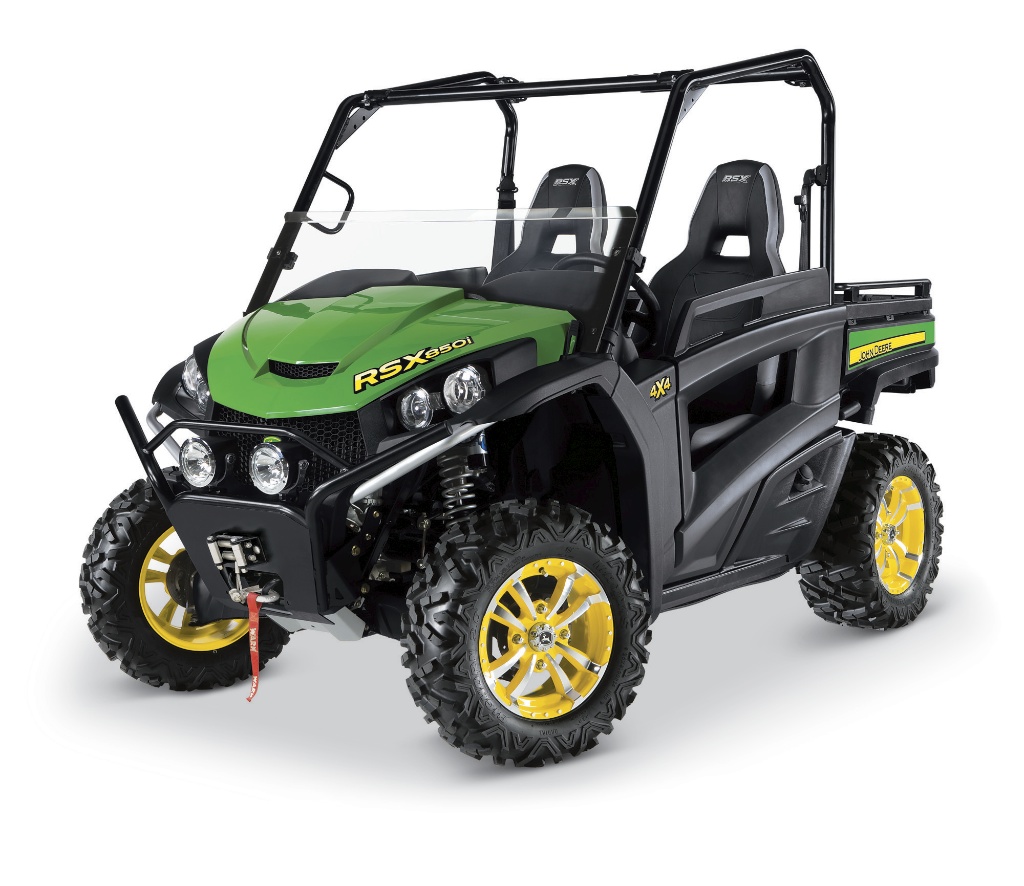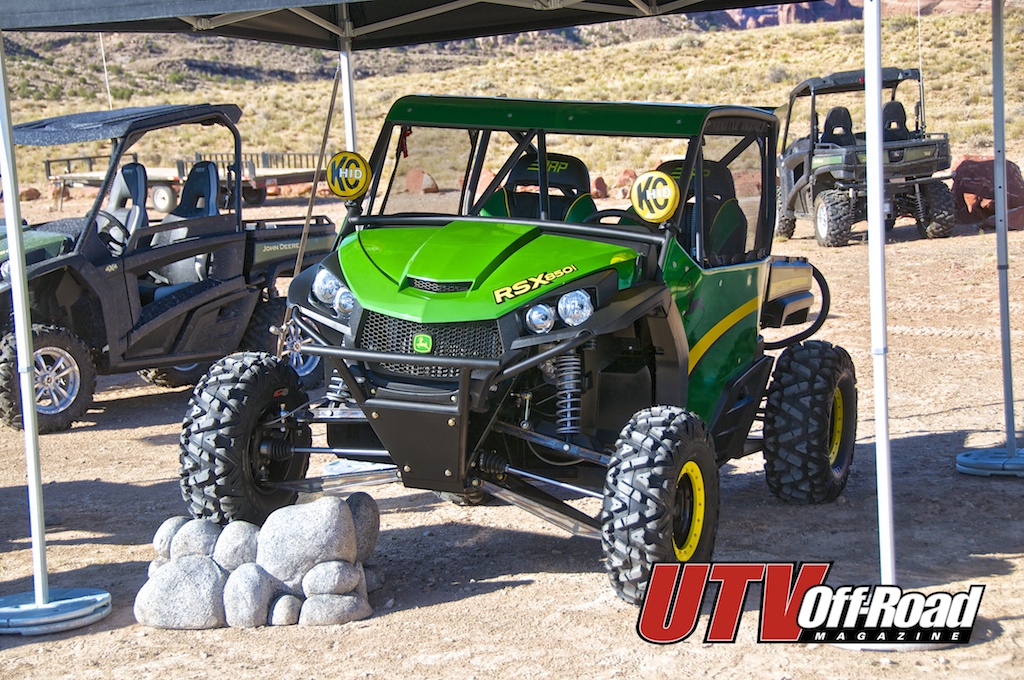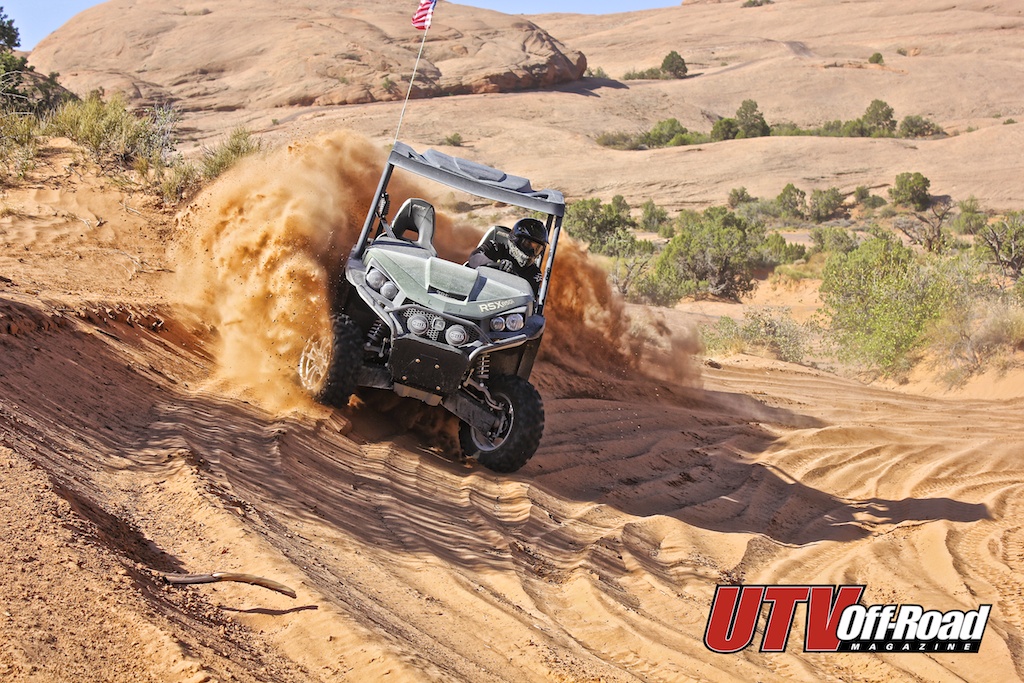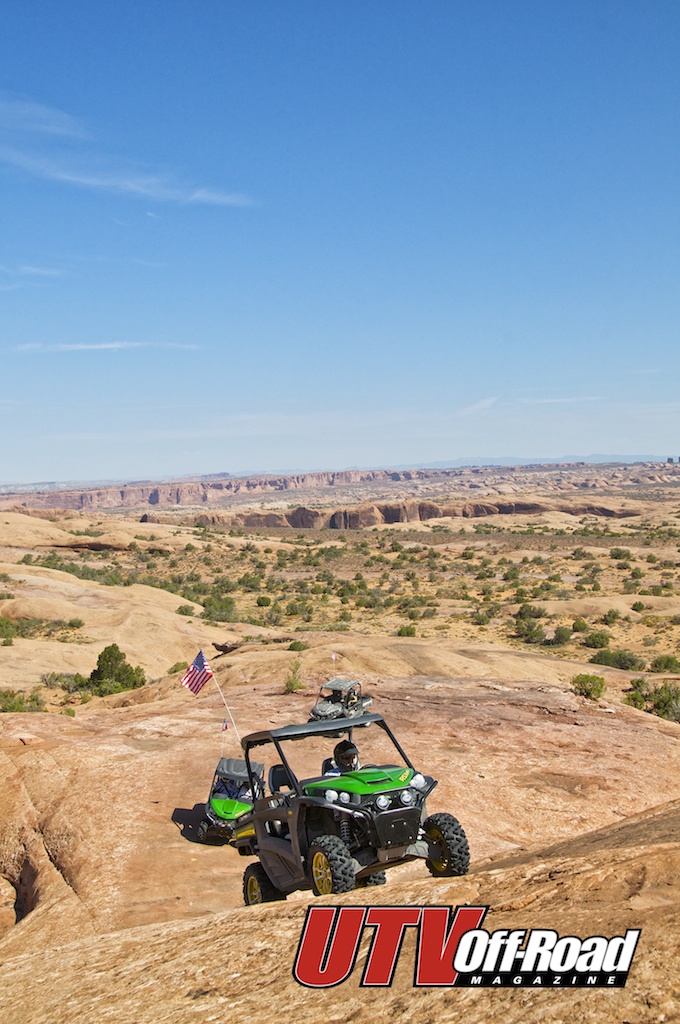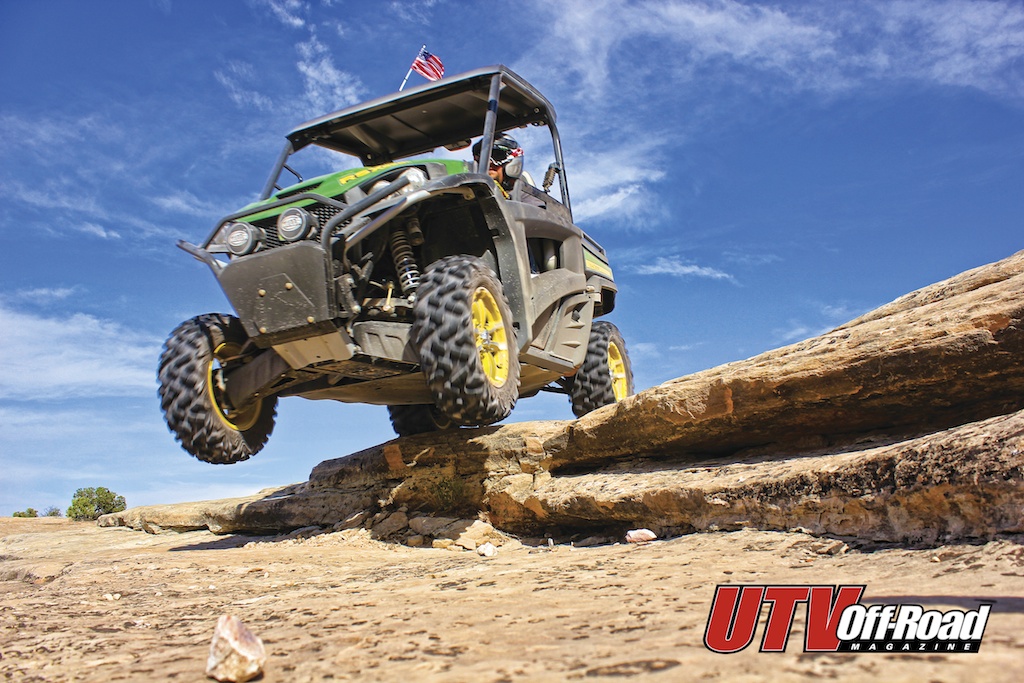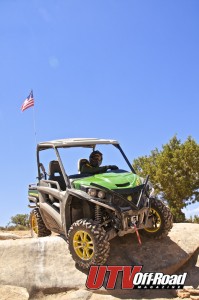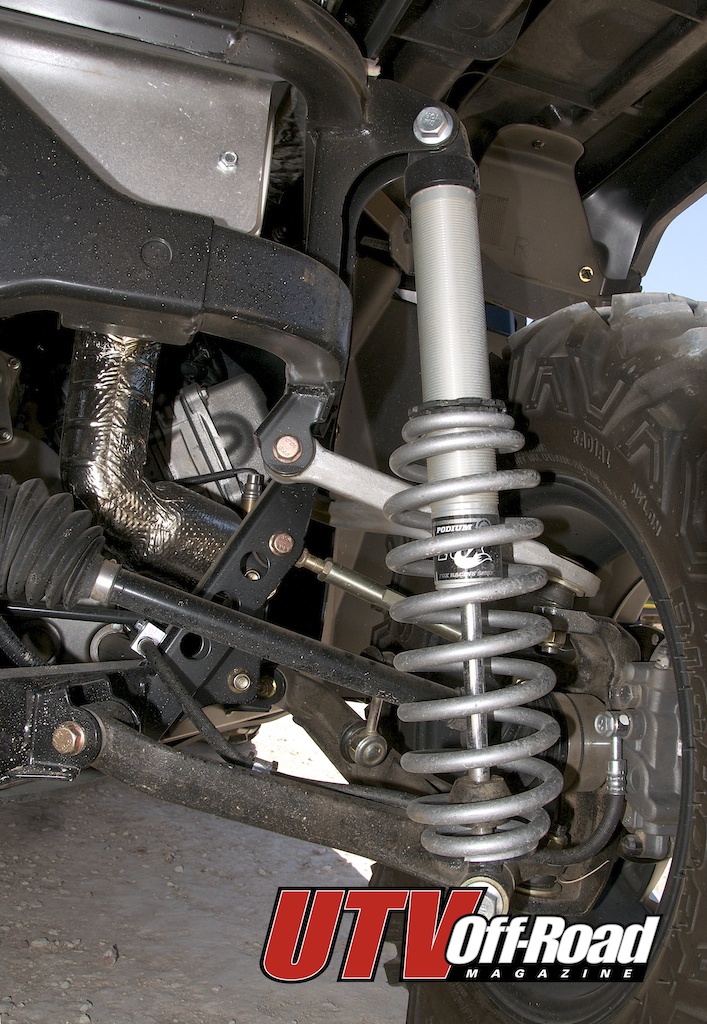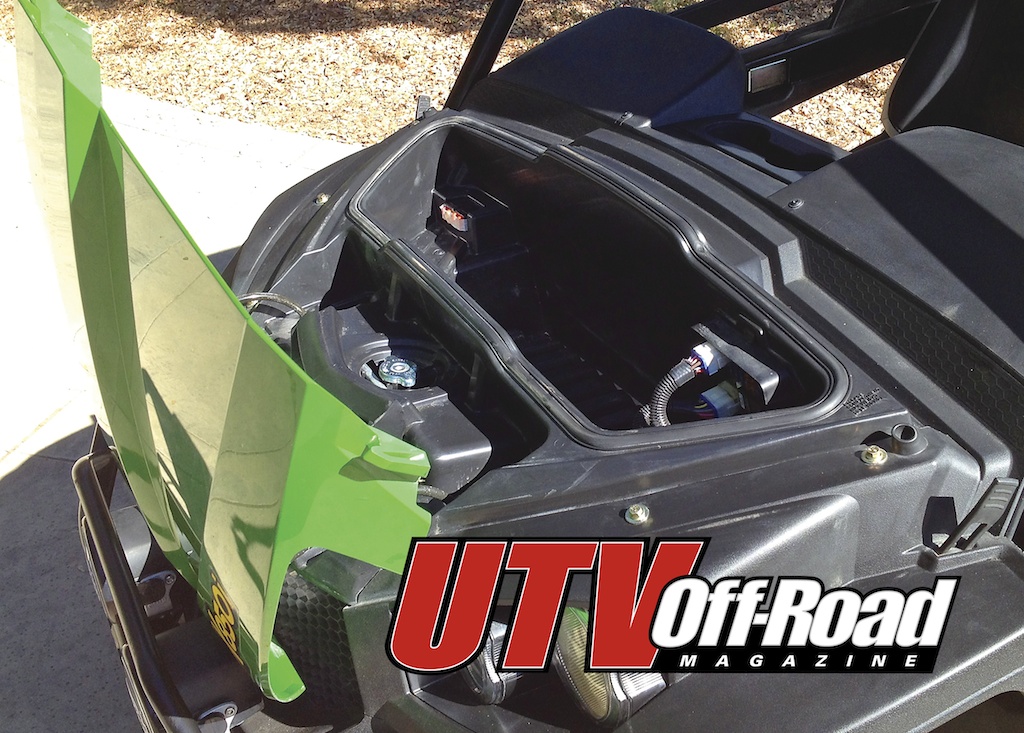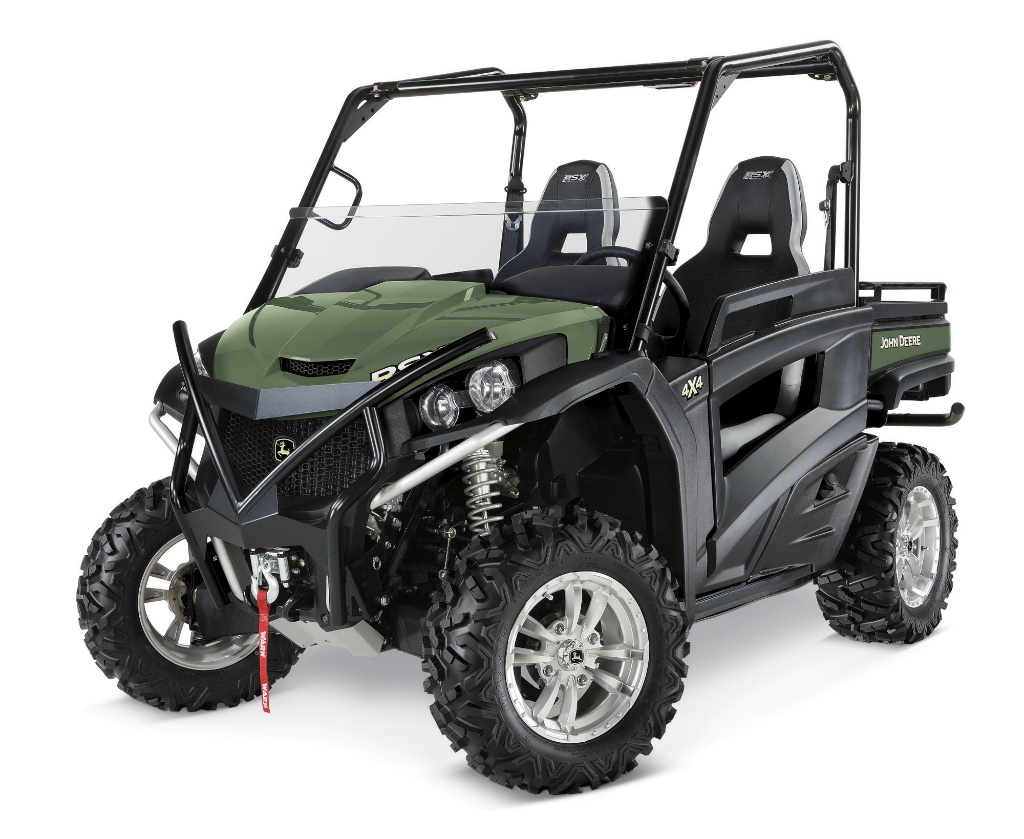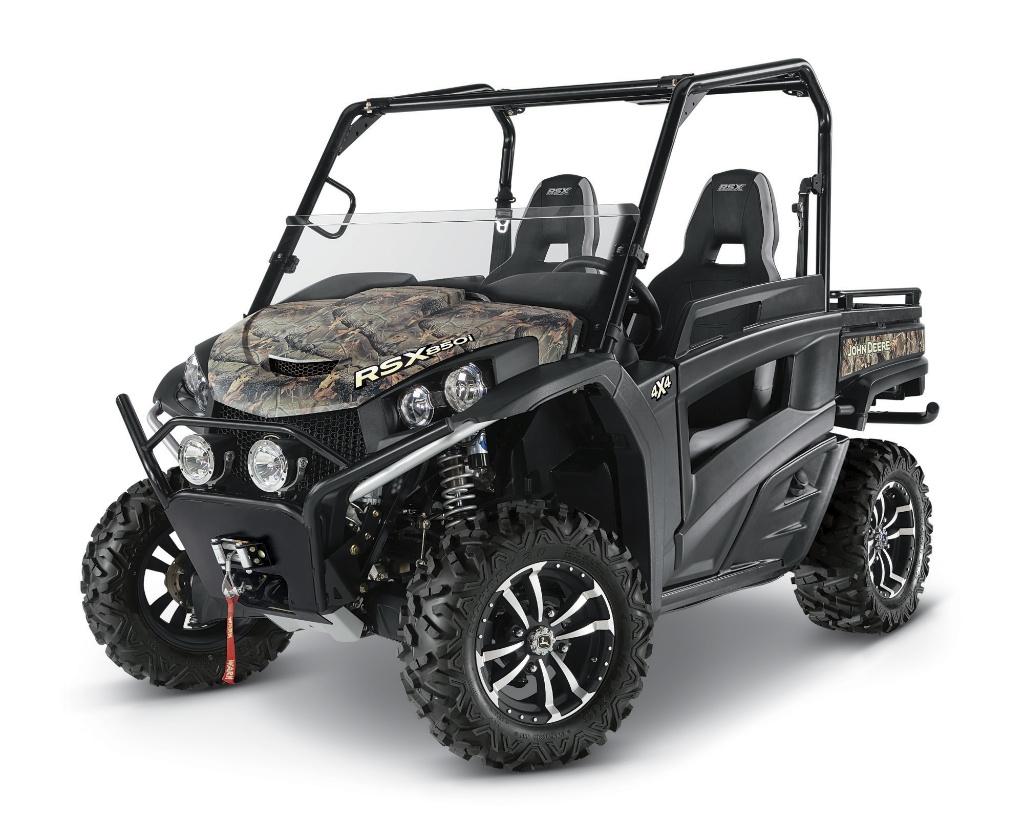In the relatively short existence of UTVs, they began to be recognized as something more than a work vehicle. We have seen major milestones in the industry as they adapt from more utilitarian functions to all out sport recreation. Some units like the Kawasaki Teryx, Arctic Cat Prowler, Yamaha Rhino, Polaris Ranger and Can-Am Commander are seated somewhere in the middle. All are capable of work tasks — some more than others — but can also tackle any trail in a mild sport fashion. We’ll categorize them as sport utility. All units with the exception of the Commander and the Prowler are close in displacement numbers, hovering between the 700 and 800cc mark. In the suspension department, again, only the Commander and Prowler offer 10 inches of wheel travel while the remanding units offer slightly less. In our initial testing, we would position the new John Deere RSX850i rests comfortably between the Kawasaki Teryx and the Can-Am Commander on the utility performance side, and between the Commander and the RZR S on the sport side.
Some JD History
In 1987 John Deere created the AMT 600, which basically was an ATC with a cargo box behind the operator and an additional rear axle for a total of 5 wheels. Just 3 years later in 1990 they introduced the AMT two-passenger that would retain the single front wheel, dual axles and two bucket seats with an operator steering wheel. In 1993 the company brought out the first Gator 4×2 and 6×4, with two front wheels and operation protection like a cage. This platform is similar to what you may see today on many farms or golf courses and was the beginning of what we would refer to as a UTV. As 2004 rolled around, JD would release the Gator HPX 4×4, a more modern design that would still remain a heavy hauler. In 2007 they started reaching out to the recreational sector with their Crossover Utility Vehicle, the 2007 Gator XUV620i, and in 2011 the Gator XUV825i. This platform would give John Deere’s core customers a solid reason to stay loyal to their favorite brand and do some true recreational activities outside of work. In late 2011, Scott Martinez built the first desert race Gator XUV825i that he has continued to race throughout 2012. For model year 2012, the Gator lineup would grow with the addition of the XUV550 and the XUV550 S4, the first multi-passenger Gator.
This all adds up to John Deere celebrating 25 years in the Utility Vehicle segment for 2012, and this marks the 20th anniversary of the Gator Brand. In September 2010 the 500,000th Gator rolled off the assembly line, and according to John Deere they have sold more utility vehicles than any other manufacturer in the industry in the past 25 years.
For 2013, John Deere is positioning their new Gator RSX850i to the outdoor enthusiast, with emphasis on recreation, and keeping it true to the Gator lineup capable of work duties. John Deere is offering the Gator RSX850i in three trim levels starting with the base model at $12,999, which features 12” Cast Aluminum wheels and Ancla MT tires, preload adjustable Fox shocks and standard bucket seats. The Gator RSX850i Trail starts out at $14,999 and is outfitted with 14” cast aluminum wheels and Maxxis Big Horn 2.0 tires, 3000lb WARN winch, front brush guard, preload adjustable Fox shocks, rear bumper and cargo box rails. Topping the list is the Sport model at $15,499. It receives Fox 2.0 performance series shocks with piggyback reservoir, sport steering wheel and prerunner front bumper and Hella lights.
ABOVE:Race Gator, anyone? The crew at Magnum Offroad developed an RSX to compete in the WORCS Production 850 class. Danny Rosenzweig from Magnum will be piloting this build in the 2013 season. Magnum also built an RSX for the BITD series to compete in Pro UTV for driver Scott Martinez who currently races a Gator XUV825i.
The RSX is built on an all-new midsize chassis and shares only a few components found on the 2012 XUV 550. They are similar, but unique to the RSX is the suspension, engine, transmission and differentials. Portions of the RSX like the operator’s station and frame were co-developed with the XUV550. The RSX is the 550’s bigger (by weight, wheelbase and length), faster and more nimble brother.
At the heart of the RSX, John Deere partnered with Italian motorcycle engine maker Piaggio to develop the 850i’s power. The 839cc OHV liquid-cooled V-twin is the same engine from the Aprilia motorcycle, tuned specifically to John Deere’s off-road utility application. With 59.5lbs/ft of torque, fuel is fed through a single 36mm closed loop EFI system and electronically controlled engine oil cooler. This Gator is ready for the trails.
The RSX’s engine is smooth, fast and furious — in stock trim, it has a unique exhaust note that sounds aggressive without being loud or annoying. The Team Industries tight belt CVT gets the power to the ground with rapid smooth acceleration up to around the 35mph mark, then tapers off as it reaches its top speed of 53mph. During our testing while in Moab, Utah, we reached numbers of 55mph on wide-open dirt roads upon hitting the rev limiter.
Above: The RSX comes equipped with an 839 cc, V-twin, liquid cooled, four-cycle, gasoline motorcycle engine that produces 62 hp and a top speed of 53 mph. John Deere claims the engine also delivers 0-30 mph acceleration in three seconds.
Moab is an off-road playground like no other with more terrain diversification open for off-roaders to actually experience and enjoy. These testing grounds are geared more towards “rock crawling,” but many trails, such as Seven Mile Rim, consist of rocky trails with a few challenging rock sections, sandy washes and trails with dune like sand and whoop sections. John Deere choosing this as a testing location speaks volumes of the type of consumer they are looking to attract. We have tested many stock vehicles over the past five years in Moab, and all we can say is that the RSX rates in the top five “sport” vehicles tested thus far. It really is that good.
Below Left: Up front, John Deere went with a ductile cast-iron top arm while the lower arms are fully boxed and welded steel arms. Right Above: Out back, John Deere went with what they refer to as a Multi-Link semi trailing-arm type suspension. As the suspension cycles up or down, you get rearward motion that gets slightly longer and wider through corners and difficult terrain. To get the hefty RSX to a halt, the Gator is equipped with hydraulic disc brakes in the front and rear. Applying the brakes will slow you down on most surfaces rather than skidding to a stop.
Below Right: The rear yields the same 9” travel with preload adjustment, as well. Lower rear arms are ductile cast-iron, whereas the upper are cast aluminum.
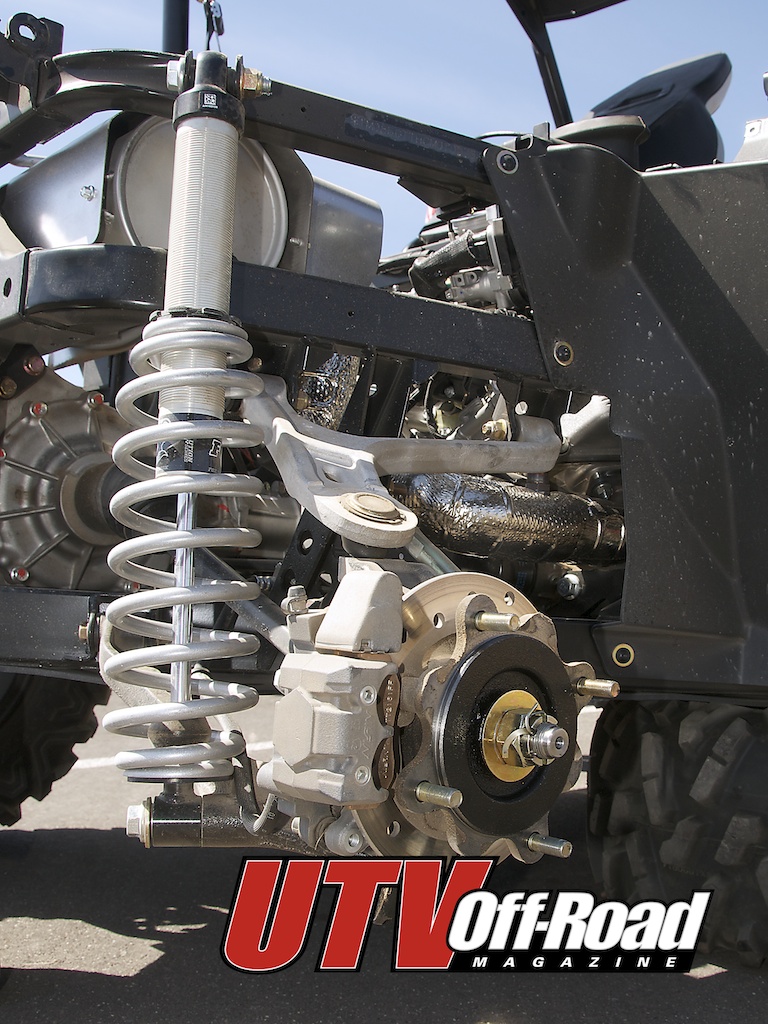
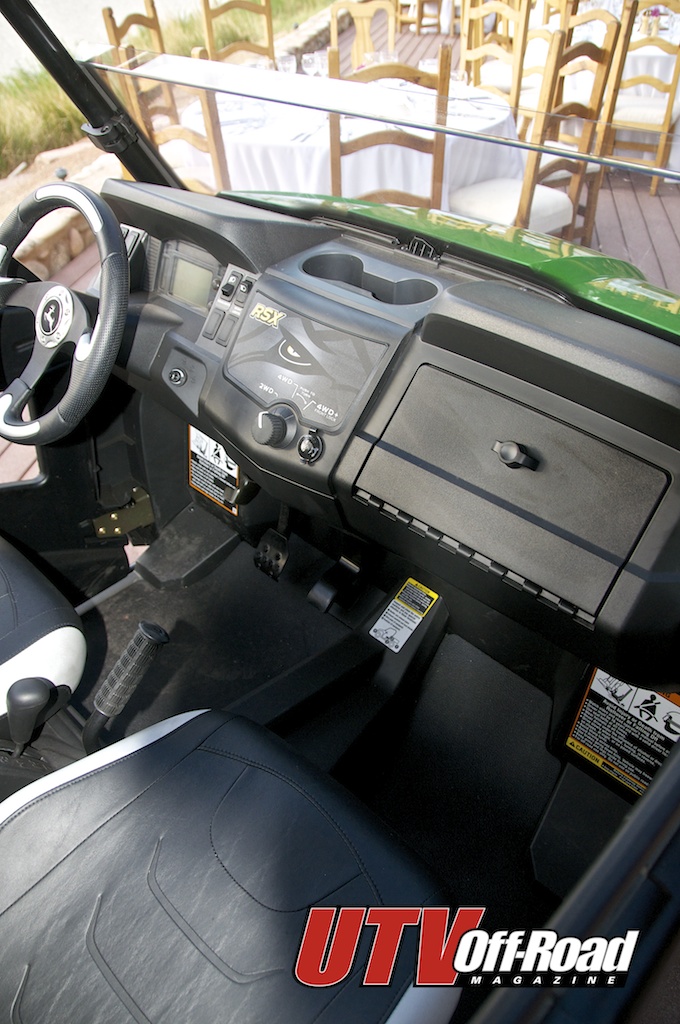 Creature Comforts
Creature ComfortsAs new models are revealed, there is one thing they have in common — nicer seats. The Commander, Wildcat and Teryx 4 all sport highback bucket seats, adding trail comfort and an upgraded appearance. The RSX Trail and Sport models also feature highback seats that look great and tilt forward to access service areas. The RSX also incorporates a large 7.4 gallon fuel tank located on the driver’s side for convenient refueling. Three-point seatbelts are standard on all models, but we would like to see an anti-cinch mechanism incorporated for increased comfort. Large automotive style latching doors offer style and protection from trail debris.
The new RSX will be more apt to do smaller chores due to the limited 400lb dumping cargo box capacity and 1200lb towing capacity. Located up front, users will benefit from the sealed under hood storage for the addition of medium-sized items. In the interior, a generous glove box adds additional storage to secure items while on the trail. When the trail takes a turn for the worst, the driver can easily engage the front wheels to 4WD or 4WD lock located in the center of the dash. Just above are two beverage pockets. We hope they add some rubber flanges in the future to hold in your beverages while on the trail. We would like to see this placed in an easier-to-reach location somewhere in the cab area to get it out of the sun. Placement of the digital dash is where it should be, located behind the steering wheel, and gear selection for L/H/N/R is placed between driver and passenger. In the future, we would like to see a gear indicator integrated into the digital dash to help locate gears easier. Currently shifting from Neutral to High gear, or Low to High gear can be cumbersome. Slots for the shifter arm to slip into would remedy this. Just to the passenger’s left is a handhold for added support when the trail gets bumpy.
Above Left: The interior layout of the RSX is clean. It has a sportier feel over past Gator models, which had mechanical style levers to engage the 4-wheel drive. Although the steering wheel does not tilt, it is in a good position for the driver. A quality steering wheel is included with the Sport model. Even though the RSX is not equipped with power steering, it takes little effort while sawing through tight, twisting trails. The digital dash is located just behind the steering wheel just like your car/truck. A foot-operated park brake is down low and equipped with an ignition cut-out feature that won’t allow the RSX to be ridden away when the parking brake is engaged. A large glove box adds to the spacious storage options for items that you may need easy access to.
Above Right: The RSX front hood opens up, similar to the Teryx, Rhino and Prowler, to access the radiator fill cap. Just behind that is a large water-resistant storage area perfect for additional items that you don’t want loose in the bed. Located in the storage box are fuse blocks. Up front, four 27-watt halogen headlights light the way.
More than Chores
It’s obvious that John Deere has an interest in capturing a portion of the Recreational Utility Buyer Market. This first offering will definitely make you consider this as an option. And you should. With more power, faster top speed, great suspension and aggressive styling over most competitive machines, it is worth more than a look. It’s a well-designed machine that will easily attract more than just John Deere core customers. Their top-of-the-line Sport model MSRPs at $15,499, which is $500 less than the sporty Can-Am Commander X 1000, and $1,100 more than the Teryx 4 EPS. The RSX weighs in at 1360lbs, 65lbs heavier than the Commander, but it handles its weight very well. And while it is not equipped with power steering, we feel it is not a necessity like some competitors’ side-by-sides. Cornering is precise and exhibited little body roll. The Fox shocks on the Sport model allowed us to travel through the trails at good speed as it adsorbed undulating rocky trail chop and small drop-offs with ease. The low range power is perfect for any trail that you may encounter; John Deere claims the RSX will go from 0-30 in 3 seconds. They have done a great job with the RSX850i. Although there are some minor interior enhancements we would like to see in the future, this machine is golden and may have you green with envy.
2013 John Deere Gator RSX850i Specifications
Engine 4-cycle gas, Electronic Fuel Injection (EFI) -Closed Loop System
Cylinders/Valving V-Twin, OHV
Horsepower 62
Displacement 839 cc
Maximum torque 59.5lbs/ft
Cooling system Liquid
Alternator 38 amp @ 7250 rpm,13.5V – regulated
Headlights Four 27 watt halogen
On-demand true 4WD system
Front Differential Selectable Limited Slip and Full locking
Rear Differential Locked (full-time)
Transmission Type Enclosed and sealed Continuously Variable Transmission (CVT)
Ground speed, mph 0-53 Hi Forward, 0-30 Lo Forward, 0-15 Reverse
Front/Rear Brakes Front/rear hydraulic disk
Park brake Foot brake; mechanical actuation
Suspension and Steering
Front Suspension Independent; double A-arm with coil over shocks & anti-sway bar, 9” suspension travel
Rear Suspension Independent; Semi-trailing double A-arm with coil over shocks & anti-sway bar, 9” suspension travel
Turning radius 19.7 ft.
Hitches – Front and Rear Optional 2 in. receiver (front), Standard 2 in. receiver (rear)
Seat belts 3-point seat belts
Ground Clearance 10.3 in.
Dimensions
Length/Width/Height 119 in. / 56.5 in. / 72 in.
Wheelbase 77.8
Weight (dry), lb. 1360 lb
Towing Capacity 1200 lb.
Payload Capacity 800 lb.
Cargo Box Dimensions/Volume 32.3”L x 47.6”W x 11.7”D/ 8.9 cu. ft. 400lbs
Tires, Front / Rear • Ancla MT (Mud Terrain) 25×8-12/25×10-12
(w/ steel wheels)
• Maxxis Big Horn 2.0, Radial 26×8-14/26×10-14
(w/alloy wheels) optional on base
Color Green/Yellow, Olive/Black, Camo
Storage Sealed oversized Glove Box, Under hood storage 1.82 ft3
MSRP Base: $12,999, Trail: $14,999,Sport: $15,499

